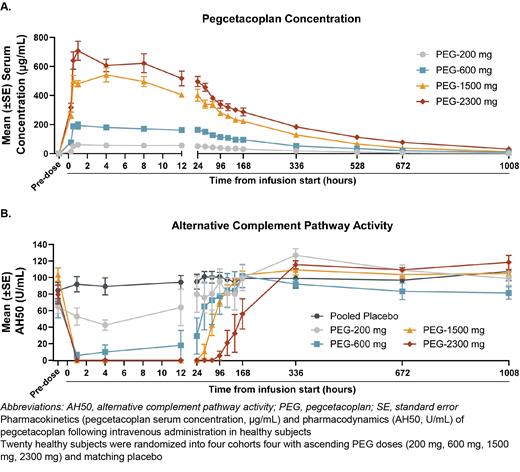Abstract
Background: The complement cascade is part of innate immunity and is involved in multiple inflammatory processes and implicated in several diseases. Pegcetacoplan (PEG) is a pegylated, cyclic peptide that binds to complement protein C3 and is a broad inhibitor of the complement cascade. Subcutaneous (SC) dosing of PEG has demonstrated efficacy in the treatment of chronic conditions, such as paroxysmal nocturnal hemoglobinuria (PNH) and was recently approved by the FDA for the treatment of PNH in adults. Intravenous (IV) PEG administration may allow for more rapid and robust reduction of uncontrolled complement activation, especially in an acute setting, such as an acute hemolytic episode in PNH.
Aims: To determine the safety, pharmacokinetics (PK), and pharmacodynamics (PD) of IV PEG in acetate-buffered saline treatment in a Phase 1 single ascending dose study (ACTRN12616000700437) in healthy subjects.
Methods: On Day 1, four cohorts with PEG doses (200mg, 600mg, 1500mg, 2300mg) received a single bolus of PEG IV (or matching placebo) administered over 30min. Blood samples for PK analyses of PEG concentration and PD analyses of alternative complement pathway hemolytic activity (AH50), total complement hemolytic activity (CH50), C3 and C3a levels were collected at 15, 30, and 60min, 4, 8, 12, and 24hrs, and Days 3, 4, 5, 6, 7, 8, 15, 22, 29, and 43. Subjects were monitored during a safety period from Day 2 to 8 by physical examination, ECG, hematology, serum chemistry, monitoring for injection site reaction and treatment emergent adverse events (TEAEs). Follow-up safety assessments were performed on Days 15, 22, 29, and 43.
Results: Twenty subjects were enrolled and allocated 4:1 to PEG or placebo per cohort (PEG-200mg, n=4; PEG-600mg, n=4; PEG-1500mg, n=4; PEG-2300mg, n=4; pooled placebo, n=4). Following a single IV dose, peak concentration (C max) of PEG was observed at 1hr post-dose (infusion start) for most cohorts (mean serum concentration: PEG-200mg, 61μg/mL; PEG-600mg, 193μg/mL; PEG-2300mg, 708μg/mL) except PEG-1500mg (occurred at 4hrs, 542μg/mL). PEG concentration at the end of infusion was similar to the observed C max. PEG concentration declined in a mono-exponential manner, with a terminal elimination half-life ranging from 200 to 285 hrs (Figure). Total body clearance of PEG after IV administration was similar across cohorts.
Early, immediate decreases in mean AH50 values were detected within 1hr in all PEG cohorts, with 1500 and 2300mg doses decreasing AH50 to undetectable levels (Figure). Decreases in mean AH50 values were maintained for at least 12, 72, 144 and 168hrs after single doses of 200, 600, 1500 and 2300mg PEG, respectively.
All PEG groups had an initial rapid decrease within 1hr in mean C3a levels, with all dose groups having trough mean C3a levels within 24hrs of dosing. Dose related decreases in mean C3a were not observed, all doses recorded a max mean decrease of 47% to 57%. No changes seen with placebo for C3a. C3 and CH50 results will be forthcoming.
Of the twenty subjects included in the study, 11 (55.0%) experienced a treatment-related adverse event (TEAE). The most common TEAEs in the PEG group were headache, (n=6, 37.5%); upper respiratory infections attributed to seasonal viral infection (n=2, 12.5%); diarrhea (n=2, 12.5%). No serious adverse events, deaths, or severe TEAEs occurred. One subject (5.0%) in the PEG-2300mg cohort experienced a moderate TEAE (infusion-related reaction, dizziness, clamminess, nausea) that led to study discontinuation.
Conclusions: These results suggest that administration of IV PEG in a sodium acetate solution has a favorable safety profile and effectively increases PEG serum concentrations while decreasing complement activity within the first hour post-dose in healthy subjects. Although the safety and efficacy of SC PEG treatment has been demonstrated in patients with PNH, IV PEG administration could serve as a useful therapeutic option for patients with a need for rapid control of complement activity. While this formulation is different than the commercially available PEG (EMPAVELI), which is administered SC and is suspended in sorbitol, the results suggest that IV PEG is well tolerated and provides the grounds for future investigations of IV PEG administration.
Grossi: Apellis Pharmaceuticals: Current Employment, Current equity holder in publicly-traded company. Yeh: Apellis Pharmaceuticals, Inc.: Current Employment, Current equity holder in publicly-traded company. Xu: Apellis Pharmaceuticals: Current Employment. Deschatelets: Apellis Pharmaceuticals: Current Employment, Current equity holder in publicly-traded company, Membership on an entity's Board of Directors or advisory committees, Patents & Royalties.
Pegcetacoplan, a subcutaneously administered C3-inhibitor that was recently approved by the US FDA for the treatment of PNH, controls IVH and prevents EVH. While subcutaneous pegcetacoplan is safe and effective, the aim of this study was to determine the safety, pharmacokinetics, and pharmacodynamics of IV pegcetacoplan in acetate-buffered saline treatment, different from current FDA approved formulation.


